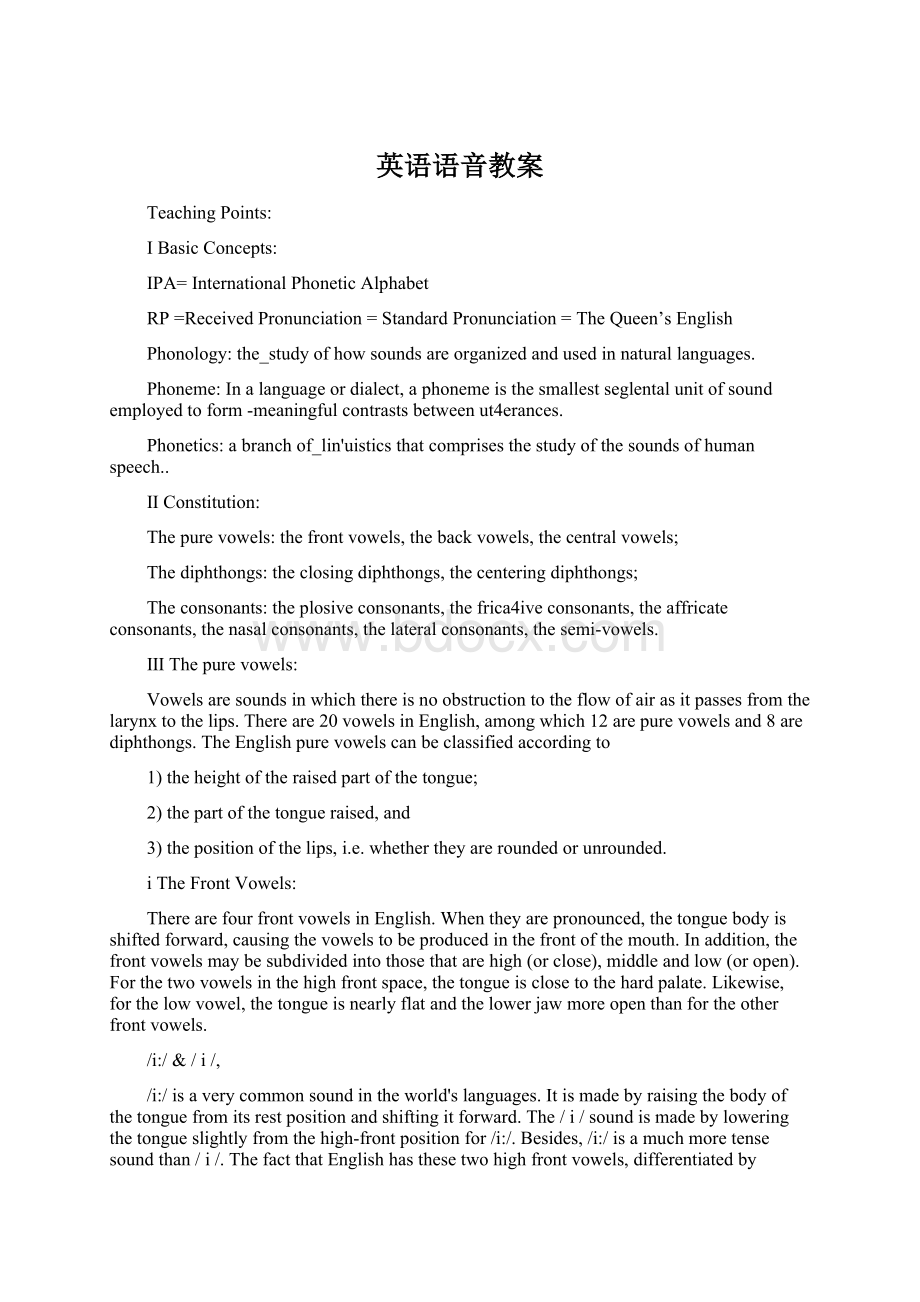英语语音教案.docx
《英语语音教案.docx》由会员分享,可在线阅读,更多相关《英语语音教案.docx(11页珍藏版)》请在冰豆网上搜索。

英语语音教案
TeachingPoints:
ⅠBasicConcepts:
IPA=InternationalPhoneticAlphabet
RP=ReceivedPronunciation=StandardPronunciation=TheQueen’sEnglish
Phonology:
the_studyofhowsoundsareorganizedandusedinnaturallanguages.
Phoneme:
Inalanguageordialect,aphonemeisthesmallestseglentalunitofsoundemployedtoform-meaningfulcontrastsbetweenut4erances.
Phonetics:
abranchof_lin'uisticsthatcomprisesthestudyofthesoundsofhumanspeech..
ⅡConstitution:
Thepurevowels:
thefrontvowels,thebackvowels,thecentralvowels;
Thediphthongs:
theclosingdiphthongs,thecenteringdiphthongs;
Theconsonants:
theplosiveconsonants,thefrica4iveconsonants,theaffricateconsonants,thenasalconsonants,thelateralconsonants,thesemi-vowels.
ⅢThepurevowels:
Vowelsaresoundsinwhichthereisnoobstructiontotheflowofairasitpassesfromthelarynxtothelips.Thereare20vowelsinEnglish,amongwhich12arepurevowelsand8arediphthongs.TheEnglishpurevowelscanbeclassifiedaccordingto
1)theheightoftheraisedpartofthetongue;
2)thepartofthetongueraised,and
3)thepositionofthelips,i.e.whethertheyareroundedorunrounded.
ⅰTheFrontVowels:
TherearefourfrontvowelsinEnglish.Whentheyarepronounced,thetonguebodyisshiftedforward,causingthevowelstobeproducedinthefrontofthemouth.Inaddition,thefrontvowelsmaybesubdividedintothosethatarehigh(orclose),middleandlow(oropen).Forthetwovowelsinthehighfrontspace,thetongueisclosetothehardpalate.Likewise,forthelowvowel,thetongueisnearlyflatandthelowerjawmoreopenthanfortheotherfrontvowels.
/i:
/&/i/,
/i:
/isaverycommonsoundintheworld'slanguages.Itismadebyraisingthebodyofthetonguefromitsrestpositionandshiftingitforward.The/i/soundismadebyloweringthetongueslightlyfromthehigh-frontpositionfor/i:
/.Besides,/i:
/isamuchmoretensesoundthan/i/.ThefactthatEnglishhasthesetwohighfrontvowels,differentiatedbymuscletensionintherootofthetongue,setsitapartfromChineseandmanylanguagesoftheworld.Both/i:
/and/i/canoccurininitial,medial,andfinalpositioninwords.
VerylittledifficultyshouldbeencounteredbytheChineselearnersinthepronunciationof/i:
/,but/i/isaproblemsound.Itiseasyforthelearnerstodetectthedifferenceinlength.Whatcountshere,however,isthedifferenceinquality.Itisthereforeimportanttopointoutthefactthattopronounceacorrect/i/,youneedto
1)loweryoutonguealittlebitfromthepositionfor/i:
/,and
2)makeitalaxsoundinsteadofatensesoundlike/i:
/.
Theimportanceofcorrectpronunciationof/i/liesinthefactthatitisthesecondmostfrequentvowelinEnglish.
/e/&/æ/
/e/isalsoanEnglishvowelwithhighfrequencyofoccurrence.Thetonguebodyisshiftedforwardinthemid-plane./æ/isproducedbyshiftingthebodyofthetongueforwardfromitsrelaxedstate,andloweringitfromthepositionfor/e/.Itisthelowestofthefrontvowels./e/and/æ/donotoccurinfinalpositioninEnglishwords.
/e/and/æ/arenotreallyproblemsoundsfortheChineselearners,butmanyofthemfailtomakeacleardistinctionbetweenthetwointheirspeech.Thedifficultyisthattheyhavetomakethecleardistinctionconsistent.
ⅱTheCentralVowels:
TherearethreecentralvowelsinEnglish:
/з:
/,/ә/and/Λ/.Whentheyarepronounced,theytendtobeproducedatapointmidwaybetweenthefrontandbackvowelsandbetweenthehighandlowvowels.
/з:
/&/ә/
/з:
/and/ә/arecentralvowels./з:
/ismadewiththetongueintheapproximatemiddleofthemouth.Itoccursonlyinstressedsyllables./ә/isalsocalledaschwa.Itismadesimilarlyto/з:
/,butwithlesstension./ә/isthemostfrequentlyusedvowelinEnglish.Both/з:
/and/ә/mayoccurinallthreewordpositions.
Mostlearnersdonothaveproblemsinthepronunciationof/з:
/and/ә/,stillweneedtogivespecialattentiontotheschwa.Theproblemwiththeschwamaynotgenerallybeinproduction,butinknowingwhentousethesound.
/Λ/
/Λ/ismadewiththetongueintheapproximatemiddleofthemouth,perhapsshiftedbackslightly.Itislowerthantheothercentralvowels/з:
/and/ә/.Thelippositionisneutral.
ⅲTheBackVowels:
TherearefivebackvowelsinEnglish.Thebackvowelsareproducedbyshiftingthebodyofthetonguebackfromitscentralposition.Thetipofthetongueremainsatthelevelofthelowerteeth.Thefrontandbackvowelshaveseveralfeaturesincommonaswellassomedifferences.Unlikethefrontvowelsthataremadewithafairlyneutrallipposture,fourofthebackvowelsarerounded.Thebackvowelsmayalsobesubdividedintothosethatarehigh(/u:
/and/u/),mid(/ɔ:
/and/ɒ/),andlow(/a:
/).
/u:
/and/u/
/u:
/and/u/arebothhigh,back,roundedvowels.The/u:
/marksthehighestboundaryforthebackvowels,as/i:
/doesforthefrontvowels.Therefore,thetongueisretractedfromitsrestpositionandraisedtowardthesoftpalate.Alongwith/u:
/,/u/completesthevowelsinthehighbackspaceonthevowelschart.Itscorrespondingfrontvowelis/i/.Whenmakingthesound,thetongueisretractedasfor/u:
/butnotelevatedtothesameextent.Inaddition,the/u/vowelisnotmadewithasmuchtensionintherootofthetongueas/u:
/.Thesametense/laxcontrastisalsoseenfor/i:
/and/i/.Thissoundisnotfoundveryfrequentlyasaphonemeinthelanguagesoftheworld,certainlynotinChinesePutonghua.InEnglish,itisnotverycommondespitethefactthatitappearsinsomefrequentlyusedwords,suchasshould,good,andbook./u:
/occursatallthethreepositionsofawordwhile/u/occursonlyinthemiddlepositionofaword,likebookandhook.Toensurecorrectpronunciation,itisimportanttomakethefollowingdistinctionbetween/u:
/and/u/:
1./u:
/isthehighestbackvowel,sotheraisedpartofthetonguefor/u:
/ishigherthanthatfor/u/;
2.thepartofthetongueraisedfor/u/isnotasbackasthatfor/u:
/;
3./u:
/hasquitestrongliproundingwhilethelipsareonlyslightlyroundedfor/u/.
/ɔ:
/&/ɒ/
/ɔ:
/isamid-backvowel.Foritsproduction,thetongueisretractedandalmostflatinthemouth.Thevowelisalmostfullybackandhasquitestronglip-rounding./ɒ/isalowvowel.Thelipsareslightlyrounded./ɒ/isadifficultvowelfortheChineselearners.Manyofthemuseashortenedversionof/ɔ:
/asitssubstitution.Toensurecorrectpronunciation,itisimportanttomakethefollowingdistinctionbetweenthesetwovowels:
1./ɒ/isalowvowelwhile/ɔ:
/isamidvowel,sothemouthismoreopenfor/ɒ/,
2./ɔ:
/hasquitestrongliproundingwhilethelipsareonlyslightlyroundedfor/ɒ/.
/a:
/
The/a:
/ismadebyloweringandflatteningthetongueintheoralcavity.Itisalowvowel,butnotasbackasotherbackvowelsinEnglish.
ⅣThediphthongs:
Thereareeightdiphthongs(alsoglidingvowels)inEnglish.Diphthongsaresoundswhichconsistofamovementofglidefromonevoweltoanother.Perhapsthemostimportantthingtorememberaboutallthediphthongsisthatthefirstpartismuchlongerandstrongerthanthesecondpart.
Theclosingdiphthongshavethecharacteristicthattheyallendwithaglidetowardsacloservowel.Becausethesecondpartofthediphthongisweak,theyoftendonotreachapositionthatcouldbecalledclose.Thecentringdiphthongsallglidetowardsthe[ә](schwa)vowel,asthesymbolsindicate.
MostChineseEFLlearnershavelittleproblemwithmostofthediphthongs,butthefollowingtwoareparticularlyimportanttoensurecorrectpronunciation.
a.Makesurethatyouhaveacorrectstartingpoint.
b.Makesurethatthediphthongsendwithaglide.
*TheTriphthongs:
amonosyllabicvowelcombinationinvolvingaquickbutsmoothmovementofthearticulatorfromonevowelqualitytoanotherthatpassesoverathird.
ⅤTheRulesofReadingofEnglishVowelLetters
ⅰrelativeconcepts
Syllables:
AsyllableisawordpartandthebasicunitofEnglishrhythm.Englishwordscanhaveone,two,threeorevenmoresyllables.(aletteroracombinationoflettersutteredtogether,oratasingleeffortorinpulseofthevoice.)
StressedSyllables:
Stressedsyllablesarethosethataremarkedinthedictionaryasstressed.(StressedsyllablesinEnglishareusuallylonger,louder,andhigherinpitch.)
*Stressedsyllablesarestrongsyllables.Unstressedsyllablesareweaksyllables.
Stressedsyllables:
-arelong
-haveapitchchange
-havefullvowelsounds.
Unstressedsyllables:
-areshort
-oftenhaveareducedvowelsound.
OpenSyllables:
Asyllableendinginavowelsound.(alsocalledfreesyllables).It
containstheabsoluteopensyllables(inasyllable,nothingcomes
afterthevowelletter)&therelativeopensyllables(inasyllable,
thevowelletterisfollowedbyaconsonantletterandamutevowel
letter).
ClosedSyllables:
Asyllableendinginaconsonant.(alsocalledcheckedsyllables)
StressedClosedSyllables:
inamonosyllabicword,thevowelletterisfollowedbyoneormoreconsonantletters.(shortvowel)
ⅱThelengthofthevowels
1.Longvowelsanddiphthongsarelongerinstressedsyllablesthanwhenfollowedbyanunstressedsyllableorsyllables.
eg.thevowel/ɔ:
/islongerincall/kɔ:
l/thanincalling/kɔ:
liŋ/,thevowel/au/inhouse/haus/islongerthaninhouses/'hauziz/.
2.Longvowelsanddiphthongsarelongerinstressedsyllablesthaninunstressedsyllables:
eg.the/ɔ:
/inrecord/ri'kɔ:
d/islongerthanthe/ɔ:
/inrecord/'rәkɔ:
d/.Similarlythe/ai/inidle/'aidl/islo